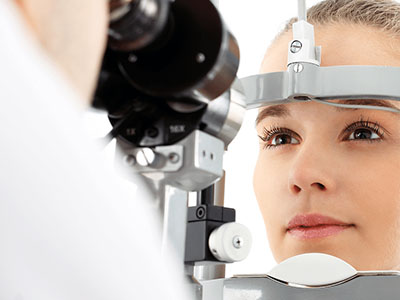DETAILED EYE EXAMINATION

A general eye examination is the process of evaluating the anatomical and functional aspects of both eyes in order to maintain eye health and diagnose diseases at an early stage. During this examination, visual acuity, eye movements, alignment and other eye-related factors are reviewed. Here are the basic procedures performed during this process:
Determination of Refractive Error
Refractive errors are measured using an autorefractometer to determine whether the patient has vision disorders such as myopia, hyperopia or astigmatism. In this way, the most appropriate eyeglass prescription is prepared for the patient. Especially in pediatric examinations, the adaptation ability of the eyes can be temporarily weakened with eye drops before autorefractometry.
Biomicroscopic Examination
Biomicroscopic examination plays an important role in the evaluation of eye health. The ophthalmologist examines the anterior segment of the eye in detail with a special microscope to evaluate the cornea, iris, lens and anterior chamber. This method is used to detect eye diseases, measure intraocular pressure and check the lens fit of contact lens users. Since eye hygiene should be observed during the examination, eye makeup should be removed and contact lenses should be removed. This examination is a critical tool for maintaining eye health and early detection of potential problems.
Visual Acuity Examination
Visual acuity is measured by reading letters, numbers or shapes arranged from largest to smallest at a distance. Corrective eyeglasses are the best vision that the eye can see without lenses or contact lenses, while the best vision with corrective eyeglasses is the vision that can be achieved with the use of glasses or lenses.
Gözlük muayenesi sırasında doktor, hastaya en iyi ve en konforlu görüşü sağlayan lens numaralarını belirlemek için çeşitli lensler deneyebilir. Bu süreçte otorefraktometre ölçümleri de dikkate alınır.
Funduscopic Examination
Funduscopic examination uses special lenses to examine the structures at the back of the eye, such as the vitreous, retina, optic nerve, and macula. Factors such as the transparency of the vitreous body within the eye, the condition of the retinal vessels, and the color of the optic nerve are evaluated to diagnose various diseases. Early stages of age-related macular degeneration can be detected with this examination, especially in individuals over the age of 60. Eye drops that cause temporary blurring may be used during the examination.
Kapsamlı bir genel göz muayenesi, yalnızca göz hastalıklarını değil, aynı zamanda diyabet, beyin tümörleri ve multipl skleroz gibi ciddi sağlık sorunlarını da erken evrede tespit etmeye yardımcı olabilir. Gözler, yaşam boyunca korunması gereken hayati duyu organlarımızdır ve düzenli kontrollerle sağlıklarını korumalıyız.
Technologies and Tests Used in General Eye Examination
Various technologies and tests used in the eye examination unit provide detailed assessment of eye health. These include:
- Ophthalmoscopy: It is a method used to examine internal structures through the pupil. Structures such as the retina, optic nerve and vessels are evaluated here.
- Retinal Tomography (OCT): It is an imaging technique used for detailed examination of the retinal layer. It plays a role in the diagnosis and follow-up of eye diseases by measuring retinal thickness.
- Tonometry: It is a test that measures intraocular pressure; high pressure can be a sign of diseases such as glaucoma.
- Eye Refraction Tests: These are tests performed to measure the refractive errors of the eye; visual acuity is determined using optical lenses.
- Eye Surface Evaluations: These are the tests used in the diagnosis of dry eye disease; the moisture of the eye surface, the condition of the eyelids and the surrounding area are examined.
- Eye Ultrasound: It is an imaging method that allows detailed examination of the posterior structures of the eye; It is used to evaluate lesions in the eye.
These technologies and tests are vital for eye doctors to assess their patients’ eye health and create treatment plans. General eye exams should be performed regularly and specialist recommendations should be taken into consideration, especially if vision problems or eye-related discomfort are experienced.
Why Should You Have Regular Eye Exams?
Regular eye exams are important for detecting and treating eye health problems early. They also help you get the right eyeglass or contact lens prescription by assessing your visual acuity. Regular eye health checks can help you identify signs of general health problems. For contact lens wearers, they can also provide advice on proper hygiene and care practices.

